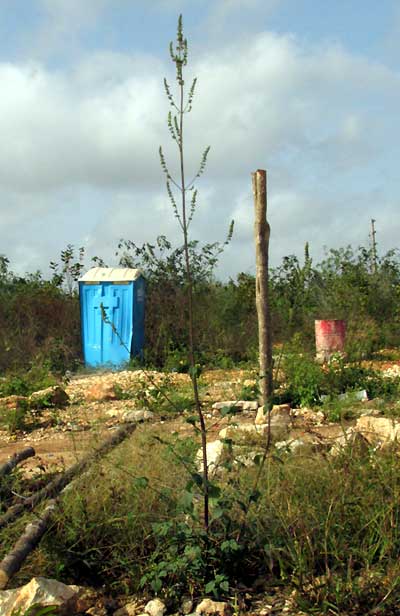Excerpts from Jim Conrad's
Naturalist Newsletter
from the March 20, 2016 Newsletter issued from Hacienda Chichen Resort beside Chichén Itzá Ruins; limestone bedrock; elevation ~39m (~128ft), N20.675°, W88.569°; central Yucatán state, MÉXICO
COMB BUSHMINT
A bumpy little trail leading off the road between Xcalacoop and Xkatún conducted the bike and me to a hot, sun-drenched rock quarry whose thin, intermittent and dried-out soil looked fairly unlivable. I figured that any weed able to survive there must be interesting.
At first only the usual species turned up, exactly what you'd expect in any such disturbed site in the tropics worldwide, but as I was leaving something different caught my eye, something in a sublimely forlorn looking spot somehow with its rangy, awkward weediness looking at home. You can see the whole thing below:

Standing eight feet tall (2.5m) the plant mostly consisted of a flowering cluster, or inflorescence, composed of tiny flowers in widely separated secondary branches. Leaves were mostly clustered at the base, and with the squared stem, looked like the herbage of something in the Mint Family, as you can see below:

The flowers were so tiny that even up close they were hard to see, as shown below:

By pushing the camera's macro capability to its limit, the images of some past-prime, bilaterally symmetrical, Mint-Family-like flowers were captured, shown below:

One of the most striking field marks couldn't be photographed -- the plant's odor when I brushed against it. Last December I described a similar smell as "minty with strong undertones of a musky-oily kind. When you smell it, for the first half second you really like it, but then the odor grows heavy and musky, and eventually almost nauseating." That was how I described the Bushmint's unsettling fragrance, our Bushmint page being at www.backyardnature.net/mexnat/bushmint.htm
In fact, the Bushmint's flowers and leaves also were similar...
And the similarities had a good cause, for both species are bushmints -- both members of the Mint Family genus Hyptis. Our rock-quarry mint is HYPTIS PECTINATA, sometimes called Comb Bushmint, maybe because the species name pectinata means "comb-like," though who knows what Linnaeus saw as comb-like about it? Comb Bushmint is native from Mexico and the Caribbean south through Central America to Brazil and Peru, plus it's invasive in tropical lands nearly worldwide.
As was the case with our earlier Bushmint, Comb Bushmint's powerful odor point to uses in traditional medicine. The online Atlas de las Plantas de la Medicina Tradicional Medicina reports that here in the Yucatan it's used against dysentery. for that ailment you grind the plant's underground parts, add sugar -- the parts are bitter -- and eat. Extracts from the flowers have been shown to be deadly to mollusks, and oils derived from the leaves have been proven to be antibiotic against a number of important bacterial pathogens.